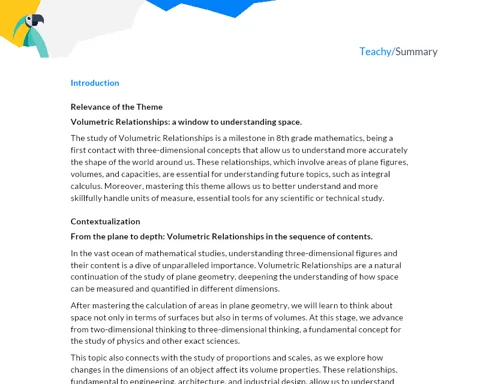INTRODUCTION: The Relevance of the Trapezoid
Relevance of the Topic
The study of quadrilaterals, particularly the trapezoid, is fundamental in Mathematics. Quadrilaterals are polygons with four sides, and like triangles, they are the basis for understanding more complex shapes and figures. The trapezoid, specifically, has unique properties and characteristics that differentiate it from other quadrilaterals, such as the presence of parallel sides and congruent opposite angles.
Contextualization
In the high school mathematics curriculum, the study of the trapezoid is part of the unit on plane geometric figures. Understanding the concepts and properties of the trapezoid is a crucial step for analyzing more complex figures, such as regular polygons, and for solving geometric problems of broader scope. Additionally, the trapezoid is one of the most common quadrilaterals in everyday life, being found in various forms, from ramps to the roof of a house. Therefore, it is essential for students to have a solid understanding of the trapezoid to ensure a full comprehension of mathematics and its practical applications. Thus, this summary provides a broad and detailed overview of the trapezoid, addressing its properties, classifications, and associated formulas.
THEORETICAL DEVELOPMENT: Components of the Trapezoid
Structure of the Trapezoid
- The Trapezoid is a convex quadrilateral that has at least one pair of parallel sides.
- The bases of a trapezoid are its parallel sides, and the non-bases are the non-parallel sides.
- The height of a trapezoid is the perpendicular distance between the two bases.
Components of the Trapezoid: Angles and Diagonals
- The Trapezoid has four internal angles that sum up to 360 degrees.
- The opposite angles of a trapezoid are congruent (meaning they have the same measure).
- The diagonals of a trapezoid are segments that connect non-adjacent vertices.
- The diagonals of a trapezoid are not congruent, but the mid-segment of each diagonal is parallel to the two bases and its measure is equal to the average of the measures of the bases (Trapezoid Mid-segment Theorem).
Types of Trapezoids
- Right Trapezoid: has two right angles (90 degrees).
- Isosceles Trapezoid: has two congruent sides and two congruent angles.
- Scalene Trapezoid: has neither congruent sides nor angles.
Formulas and Properties
- Area of the Trapezoid: The area of a trapezoid is the average of the bases multiplied by the height. The formula is A = (B + b)h/2, where A is the area, B and b are the measures of the bases, and h is the height.
- Perimeter of the Trapezoid: The perimeter is the sum of the lengths of all sides.
- Relationship between the bases: In a non-isosceles trapezoid, the difference between the measures of the bases is the base for the height multiplied by the segment parallel to the base that joins the midpoints of the non-parallel sides.
DETAILED SUMMARY: Key Points
Relevant Points
- Definition of Trapezoid: A convex quadrilateral with at least one pair of parallel sides. The bases are the parallel sides and the height is the distance between them, measured perpendicularly.
- Classifications of Trapezoids: There are three types of trapezoids - right, isosceles, and scalene, differing in the measure of angles and sides.
- Trapezoid Mid-segment Theorem: The measure of any segment parallel to the bases and connecting the midpoints of the non-parallel sides of a trapezoid is equal to the average of the measures of the bases.
Conclusions
- Importance of the Trapezoid: Mastery of the concept of the trapezoid is essential for understanding other geometry topics, aiding in the resolution of more complex problems.
- Trapezoid Mid-segment Theorem: This is a unique and vital property of the trapezoid, as it helps establish relationships between different components of the quadrilateral.
Suggested Exercises
- Calculate the area: Given a trapezoid with bases measuring 6 cm and 8 cm, and a height of 4 cm, calculate the area.
- Identify the type of trapezoid: In a quadrilateral, the angles are in order 80°, 100°, 80°, and 100°. Can it be stated that this quadrilateral is a trapezoid? If so, what type?
- Use the Trapezoid Mid-segment Theorem: In trapezoid ABCD, with AB parallel to CD, E and F are the midpoints of AB and CD, respectively. If EF measures 4 cm, and AB and CD measure, respectively, 6 cm and 12 cm, what is the perimeter of the trapezoid?
Remember: You are the master of trapezoids. Spare them, cut them, add to them, have fun with them. Mold them in your teaching like a divine craftsman. Lead your students to applaud geometry!



